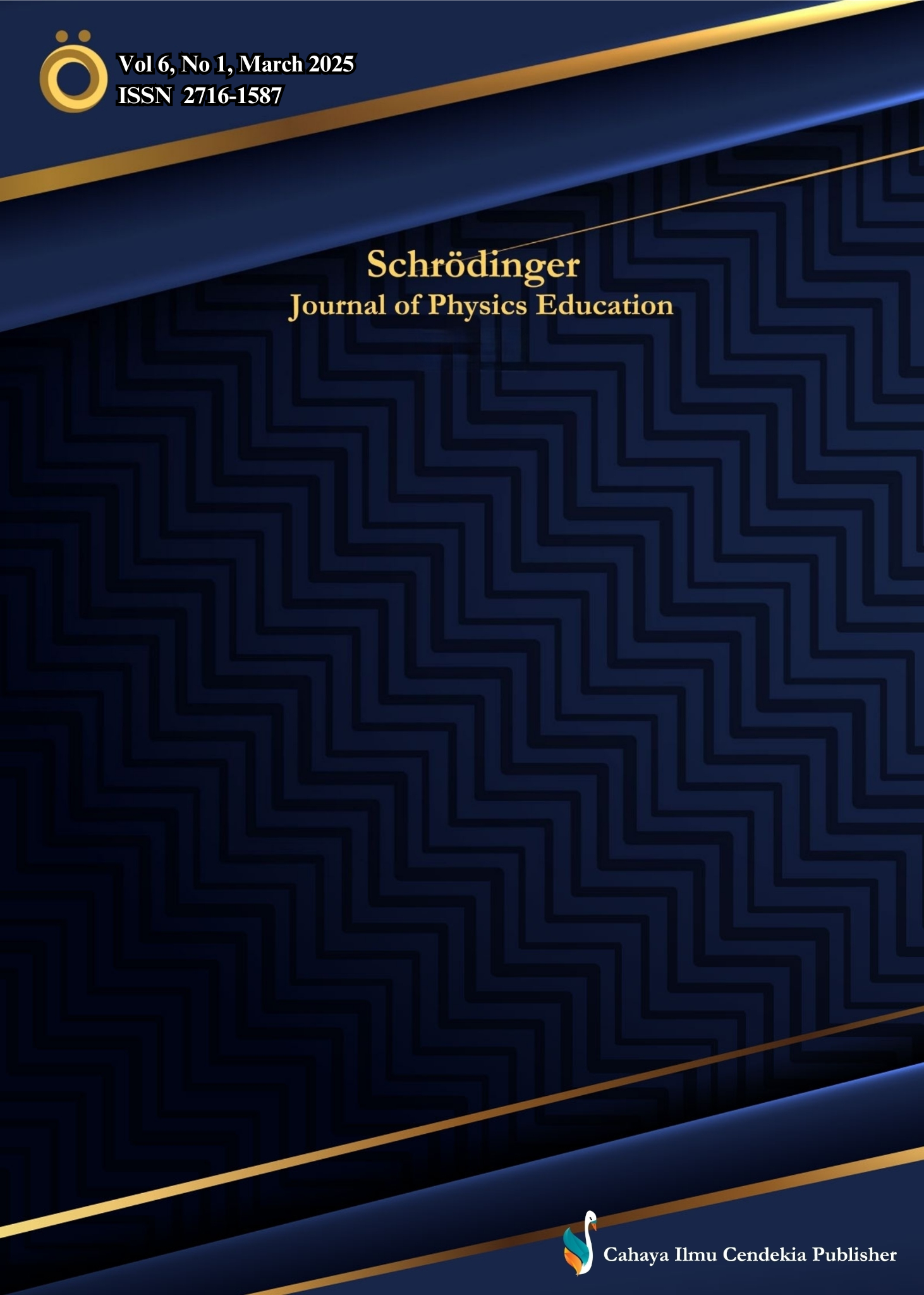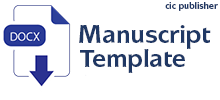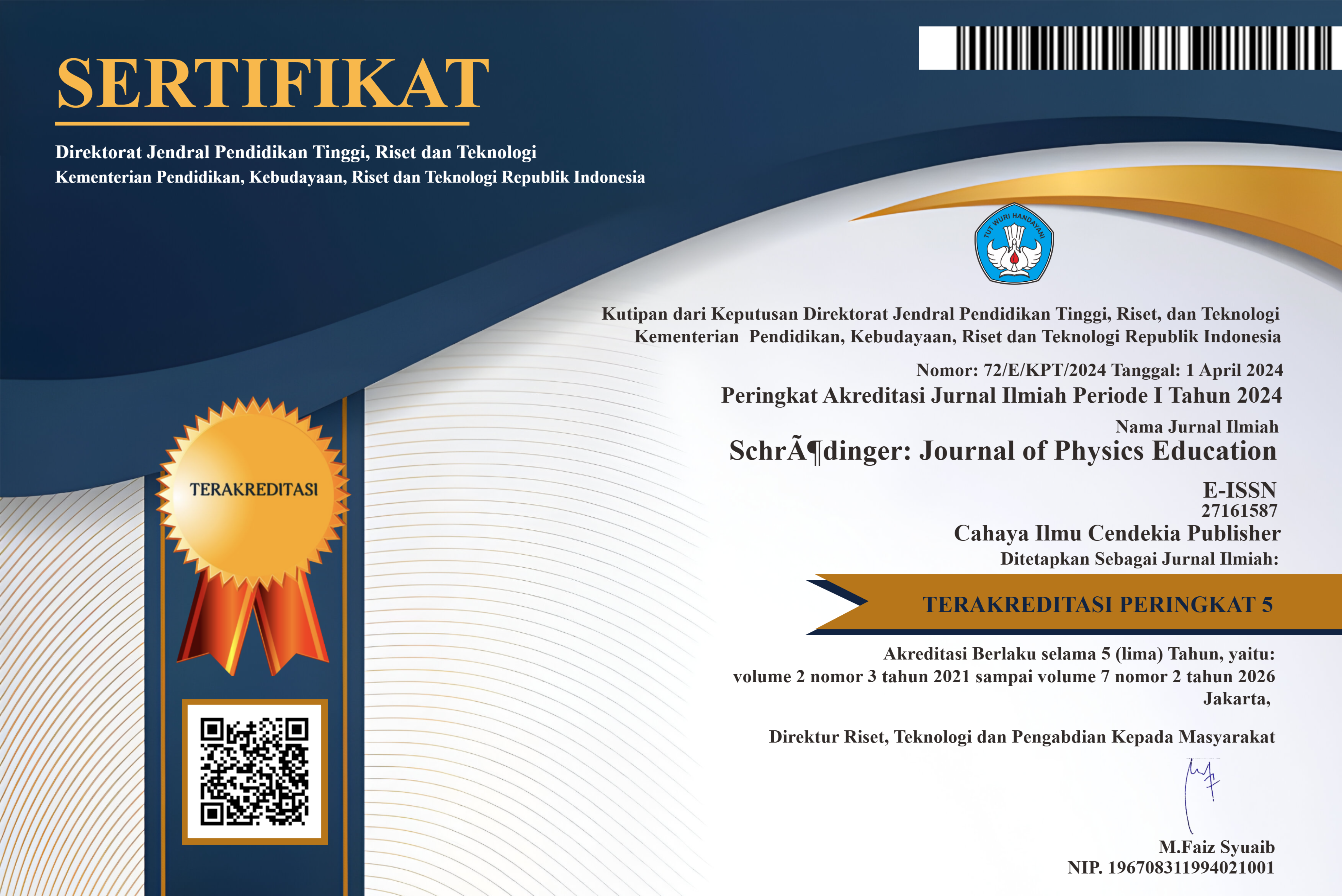Enhancing Conceptual Understanding of Electric Circuit Analysis through the Jigsaw Method: A Quasi-Experimental Study in Senior High Schools
Abstract
Purpose of the study: This study examines the effectiveness of the Jigsaw cooperative learning method in improving Form 1 students' understanding of electric circuit analysis, problem-solving skills, and its impact compared to traditional teaching.
Methodology: A quasi-experimental pre-test and post-test design was employed, involving 87 students from Obiri Yeboah SHS and Dadieso SHS. Over a one-week intervention, the Jigsaw method was integrated into regular physics lessons. Data were collected through tests and questionnaires administered before and after the intervention to assess the students’ knowledge and learning experiences. SPSS was used for statistical analysis, evaluating the effectiveness of the Jigsaw method in improving conceptual understanding.
Main Findings: The results demonstrated a significant increase in students' comprehension of electric circuits. At Obiri Yeboah SHS, the average score rose from 50.19 (pre-test) to 83.69 (post-test), and at Dadieso SHS, from 46.50 to 86.57. The Jigsaw method not only improved students' understanding of the subject but also enhanced their problem-solving abilities, communication skills, and motivation to learn. Statistical analyses, including t-tests and Cohen’s d, indicated a strong, significant effect size, reinforcing the method’s effectiveness.
Novelty/Originality of this study: This study provides compelling evidence of the Jigsaw method’s ability to enhance student performance and deepen conceptual understanding in science education, particularly in electric circuit analysis. The findings underscore the importance of cooperative learning techniques in promoting active participation, peer teaching, and higher levels of student engagement, suggesting that such strategies are critical for fostering more interactive and impactful classroom experiences.
References
F. Addo-Wuver et al., “Improvement of senior high students’ performance in heat transfer using practical activities in effutu municipal, Ghana,” Eur. J. Educ. Stud., vol. 10, no. 9, pp. 438–446, 2023, doi: 10.46827/ejes.v10i9.4997.
M. Al Amin, S. Hedon, S. Abdullah, and H. El-mahalawy, “Analysis of the Influence of Students ’ Attitudes on High School Students ’ Learning Motivation,” vol. 4, no. 3, 2023, doi: 10.37251/sjpe.v4i3.705.
B. K. Blajvaz, I. Z. Bogdanović, T. S. Jovanović, J. D. Stanisavljević, and M. V. Pavkov-Hrvojević, “The jigsaw technique in lower secondary physics education: students’ achievement, metacognition and motivation,” J. Balt. Sci. Educ., vol. 21, no. 4, pp. 545–557, 2022, doi: 10.33225/jbse/22.21.545.
D. Amankwaah, E. Appiah-twumasi, K. D. Ateko, and Y. D. Asamoah, “Efficacy of ADDIE instructional design in promoting conceptual change in electronic concepts at tano-north municipality, Ghana,” Schrödinger J. Phys. Educ., vol. 5, no. 3, pp. 76–87, 2024, doi: 10.37251/sjpe.v5i3.1064.
L. Tobaja, J. Gil, and F. Solano, “Collaborative learning: use of the jigsaw technique in mapping concepts of physics,” Probl. Educ. 21St Century, vol. 75, no. 1, pp. 92–101, 2017, [Online]. Available: http://www.scientiasocialis.lt/pec/node/files/pdf/vol75/92-101.Márquez_Vol.75-1_PEC.pdf
S. O. Pela, N. N. Le, P. G. Kaboro, and A. Nurjamil, “Innovation of physics e-module : utilizing local wisdom of Lampung ’ s handwritten batik in teaching heat and temperature material to foster students ’ scientific attitude,” SchrödingerJournal Phys. Educ., vol. 4, no. 4, pp. 132–138, 2023, doi: 10.37251/sjpe.v4i4.924.
A. Astalini, D. A. Kurniawan, D. Darmaji, E. Erika, R. Hoyi, and W. Sukarni, “Description of student response on the implementation of cooperative learning models of jigsaw and role playing on the physics learning,” J. Pendidik. Fis. Indones., vol. 17, no. 1, pp. 77–85, 2021, doi: 10.15294/jpfi.v17i1.24315.
A. Aydin and F. Biyikli, “The effect of jigsaw technique on the students’ laboratory material recognition and usage skills in general physics laboratory-i course,” Univers. J. Educ. Res., vol. 5, no. 7, pp. 1073–1082, 2017, doi: 10.13189/ujer.2017.050701.
M. Josiah, “Jigsaw iv cooperative learning strategy and students’ motivation towards senior secondary physics in Jos Metropolis, Nigeria,” Int. J. Res. Find. Eng. Sci. Technol., vol. 4, no. 2, pp. 1–16, 2022, doi: 10.48028/iiprds/ijrfest.v4.i2.01.
S. Saker, “The effectiveness of using jigsaw strategy on Palestinian tenth graders’ English grammar learning,” 2015. [Online]. Available: https://search.mandumah.com/Record/695810
R. Berger and M. Hänze, “Impact of Expert Teaching Quality on Novice Academic Performance in the Jigsaw Cooperative Learning Method,” Int. J. Sci. Educ., vol. 37, no. 2, pp. 294–320, Jan. 2015, doi: 10.1080/09500693.2014.985757.
R. L. Oxford, “Cooperative learning, collaborative learning, and interaction: Three communicative strands in the language classroom,” Mod. Lang. J., vol. 81, no. 4, pp. 443–456, 1997, doi: 10.1111/j.1540-4781.1997.tb05510.x.
A. Furco, The community as a resource for learning: An analysis of academic service-learning in primary and secondary education. 2010. doi: 10.1787/9789264086487-12-en.
A. L. Brown and A. S. Palincsar, “Guided, cooperative learning and individual knowledge acquisition,” in Knowing, learning, and instruction, Routledge, 2018, pp. 393–451. [Online]. Available: https://www.taylorfrancis.com/chapters/edit/10.4324/9781315044408-13/guided-cooperative-learning-individual-knowledge-acquisition-ann-brown-annemarie-palincsar
Q. Mengduo and J. Xiaoling, “Jigsaw strategy as a cooperative learning technique: focusing on the language learners,” Chinese J. Appl. Linguist. (Foreign Lang. Teach. Res. Press., vol. 33, no. 4, pp. 113–125, 2010, [Online]. Available: https://www.semanticscholar.org/paper/Jigsaw-Strategy-as-a-Cooperative-Learning-on-the-Qiao/e579cb8d0bcb3572bdbe53f4aa6087a17657a669
D. Kaufman, E. Sutow, and K. Dunn, “Three approaches to cooperative learning in higher education,” Can. J. High. Educ., vol. 27, no. 2/3, pp. 37–66, 2017, doi: 10.47678/cjhe.v27i2/3.183303.
N. Frey, D. Fisher, and S. Everlove, Productive group work: How to engage students, build teamwork, and promote understanding. Ascd, 2009. [Online]. Available: https://books.google.co.id/books?hl=en&lr=&id=kmOW2j-f7h8C&oi=fnd&pg=PA1&dq=Productive+group+work:+How+to+engage+students,+build+teamwork,+and+promote+understanding.+&ots=DsukNlG90n&sig=v0psRWk6Y4A2sNbK9CKbwCQOC4w&redir_esc=y#v=onepage&q=Productive group
N. H. Jainal and M. Shahrill, “Incorporating jigsaw strategy to support students’ learning through action research,” Int. J. Soc. Educ. Sci., vol. 3, no. 2, pp. 252–266, 2021, doi: 10.46328/ijonses.75.
M. J. Prince and R. M. Felder, “Inductive teaching and learning methods: Definitions, comparisons, and research bases,” J. Eng. Educ., vol. 95, no. 2, pp. 123–138, 2006, doi: 10.1002/j.2168-9830.2006.tb00884.x.
I. K. Acquah, M. Gyan, D. Appiah, B. O. Ansah, R. Wilson, and E. Mensah, “Improving students ’ performance in resolution of vectors using PhET interactive simulations,” Schrödinger J. Phys. Educ., vol. 5, no. 3, pp. 107–116, 2024, doi: 10.37251/sjpe.v5i3.1078.
E. A. A. Abuhamda, “The effect of jigsaw cooperative learning strategy on fourth graders ’ achievement in teaching efl at Qalqilya City,” Acad. J. Bus. Soc. Sci., vol. 4, pp. 1–8, 2020.
S. Hadi, “Effectiveness of jigsaw technique in teaching passive voice,” J. Corner Educ. Linguist. Lit., vol. 3, no. 2, pp. 121–133, 2023, doi: 10.54012/jcell.v3i2.208.
A. J. Nalls, “Teachers’ Perceptions of the Acceptability of the Jigsaw Method: An Exploration of Implementation Barriers and Faciliators,” 2022, University of Southern Maine. [Online]. Available: https://www.proquest.com/openview/6a3cb525e8ce046d1e3f5bca75168616/1?cbl=18750&diss=y&pq-origsite=gscholar
G. A. Busari, “Interactive-Lecture-Demonstrations and Guided-Reverse Jigsaw Instructional Strategies, And Secondary School Students’ learning Outcomes in Concepts of Light in Physics in Oyo State, Nigeria,” 2023, University Of Ibadan, Ibadan. [Online]. Available: https://pgsdspace.ictp.it/xmlui/handle/123456789/2069
T. Costouros, “Jigsaw cooperative learning versus traditional lectures: Impact on student grades and learning experience,” Teach. Learn. Inq., vol. 8, no. 1, pp. 154–172, 2020, doi: 10.20343/TEACHLEARNINQU.8.1.11.
E. K. Baken, D. C. Adams, and M. S. Rentz, “Jigsaw method improves learning and retention for observation-based undergraduate biology laboratory activities,” J. Biol. Educ., vol. 56, no. 3, pp. 317–322, 2022, doi: 10.1080/00219266.2020.1796757.
P. Yuliza, “An analysis of the strength of Jigsaw in Teaching and Learning,” 2020, UIN Ar-Raniry Banda Aceh, Aceh. [Online]. Available: https://repository.ar-raniry.ac.id/id/eprint/13480/
C. Roseth, Y.-K. Lee, and W. Saltarelli, “Reconsidering jigsaw social psychology: Longitudinal effects on social interdependence, sociocognitive conflict regulation, motivation, and achievement,” J. Educ. Psychol., vol. 111, no. 1, Jan. 2019, doi: 10.1037/edu0000257.
M. Riant et al., “Does the jigsaw method improve motivation and self-regulation in vocational high schools?,” Contemp. Educ. Psychol., vol. 77, p. 102278, 2024, doi: https://doi.org/10.1016/j.cedpsych.2024.102278.
S. T. Yimer and N. N. Feza, “Learners’ conceptual knowledge development and attitudinal change towards calculus using jigsaw co-operative learning strategy integrated with GeoGebra,” Int. Electron. J. Math. Educ., vol. 15, no. 1, pp. 1–26, 2019, doi: 10.29333/iejme/5936.
O. Sagsoz, O. Karatas, V. Turel, M. Yildiz, and E. Kaya, “Effectiveness of Jigsaw learning compared to lecture-based learning in dental education,” Eur. J. Dent. Educ., vol. 21, no. 1, pp. 28–32, 2017, doi: 10.1111/eje.12174.
T. K. Kim, “T test as a parametric statistic,” Recipes Sci., vol. 68, no. 6, pp. 540–546, 2015, doi: 10.4097/kjae.2015.68.6.540.
M. S. Thiese, B. Ronna, and U. Ott, “P value interpretations and considerations,” J. Thorac. Dis., vol. 8, no. 9, pp. E928–E931, 2016, doi: 10.21037/jtd.2016.08.16.
H. Karimi Moonaghi and M. Bagheri, “Jigsaw: a good student-centered method in medical education,” Futur. Med. Educ. J., vol. 7, no. 1, pp. 35–40, 2017, doi: 10.22038/fmej.2017.8757.
M. Jafariyan, M. Matlabi, R. Esmaeili, and M. Kianmehr, “Effectiveness of teaching: Jigsaw technique vs lecture for medical students’ physics course,” Bali Med. J., vol. 6, no. 3, p. 529, 2017, doi: 10.15562/bmj.v6i3.400.
Copyright (c) 2025 Isaac Kwesi Acquah

This work is licensed under a Creative Commons Attribution 4.0 International License.
Authors who publish with this journal agree to the following terms:
- Authors retain copyright and acknowledge that the Schrödinger: Journal of Physics Education is the first publisher licensed under a Creative Commons Attribution 4.0 International License.
- Authors are able to enter into separate, additional contractual arrangements for the non-exclusive distribution of the journal's published version of the work (e.g., post it to an institutional repository or publish it in a book), with an acknowledgment of its initial publication in this journal.
- Authors are permitted and encouraged to post their work online (e.g., in institutional repositories or on their website) prior to and during the submission process, as it can lead to productive exchanges and earlier and greater citation of published work.







.png)
.png)








.png)
.png)
.png)








